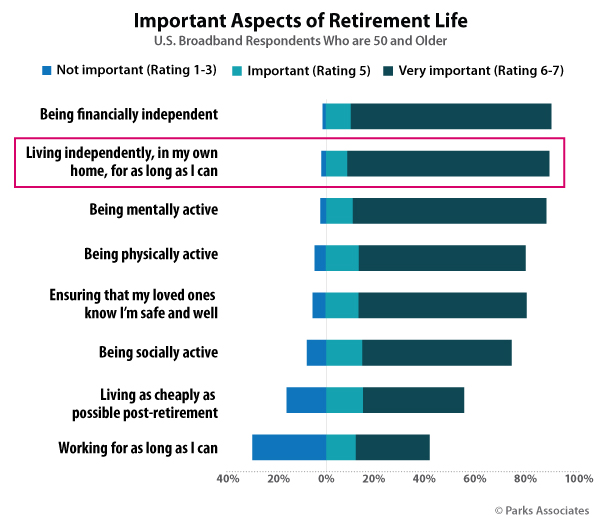Apple Watch Fall Detection Opens New Avenues for Independent Living Market
When the Apple Watch Series 4 was released in September 2018, a number of new health-related smartwatch features made their debut. The newly built-in ECG feature, and the most recently announced enhanced sleep tracking feature, have been the focus of many reviews; however, the fall detection capability may prove to be one of the most valuable features the Apple Watch has to offer.
The Center for Disease Control (CDC) reports that between the years 2007 and 2016, fall death rates in the U.S. increased by approximately 30%. A fifth of those falls caused serious injury such as broken bones, and emergency medicine personnel identified falls as the leading cause of Traumatic Brain Injury (TBI). Nearly three million older people are treated in emergency rooms in the US each year for these types of fall injuries, and Parks Associates research shows that approximately half of older consumers and their caregivers/future caregivers are concerned about the possibility of accidents and emergencies in their retirement years. With Baby Boomers now firmly in their golden years, fall-related injuries pose a threat to the independence of nearly a quarter of the domestic population.
Parks Associates research also shows 84% of people age 50+ rate living independently in their own home for as long as possible as very important, and this population and their caregivers are looking for ways to make this feasible.

Currently, uptake of traditional panic-button solutions (Personal Emergency Response Systems) hovers between 6% and 9% of seniors in broadband households. Though the need is high, many seniors avoid purchasing the devices due to their poor design and aesthetics, and seniors’ desire to avoid being seen as feeble or unwell. The prospect of wearing a design-forward watch from a leading consumer electronics manufacturer—with the added benefit of fall detection—may shake this market open. In fact, Samsung preceded Apple to the market in its partnership with MobileHelp, which provisions special Samsung Gear watches with fall detection to its senior subscribers.
The fall detection feature on the latest Apple Watch, with Apple’s substantial marketing resources, could push the independent aging market to the next level. The smart watch uses its accelerometer and gyro sensors to determine if the person wearing the device has taken a tumble. It then “taps you on the wrist, sounds an alarm, and displays an alert.” Once the alert is displayed, the user has the option to dismiss it or alert emergency services. If neither option is selected within one minute, the Apple Watch will alert emergency services that you have fallen with your location. This feature is automatically turned on for any wearer over the age of 65.
There are potential downsides that the Apple Watch must overcome if it wants to expand its presence in the market for wearable, connected health monitoring products geared toward the older demographic. With a starting price point of $399, many people—particularly seniors on a fixed income—may find the Apple Watch unaffordable. If a senior or their caregiver wants the added security and benefit of the watch having stand-alone cellular service, they’re looking at a $499 price tag. Another potential issue is the short battery life of the Apple Watch. The battery will hold a charge for about a day, leading many users to charge it overnight. However, overnight is when many seniors are at an increased risk for falling and when the fall detection and emergency alert services may be needed most.
Downsides notwithstanding, the health-monitoring features on the Apple Watch have the potential to change the game for seniors and their caregivers looking for solutions that allow seniors to safely continue living in their homes. Parks Associates research shows steady growth in overall adoption of connected health devices over the past five years, with wearables driving growth in the market overall.
According to the AARP, the 65+ population is expected to double from 2006 to 2030. This information alone should motivate companies such as Apple to continue innovation in the connected health device market, with a focus on accessibility moving forward. For a deeper look at connected health devices and their impact on independent living, check out Parks Associates latest 360 View: Heath and Independent Living.
Are you coming to Parks Associates’ Connected Health Summit: Independent Living and Wellness in San Diego from August 27-29, 2019? We are currently accepting presentation proposals, and online registration opens March 15!
Further Reading:
- Market Snapshot - Consumer Health Attitudes and IoT Home Living Features
- 50% of consumers 50 and older very interested in emergency panic button service or home emergency system
- Incentivizing Behavior Change: Improving Connected Health Outcomes
Next: What is the Future of Independent Living? Insights from Ada Health
Previous: Health Systems: Five Ways Telehealth Can Impact Performance Webcast Overview
Comments
-
Be the first to leave a comment.
Post a Comment
Have a comment? Login or create an account to start a discussion.


